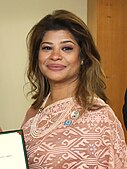Sir Salimullah Medical College
 From Wikipedia - Reading time: 17 min
From Wikipedia - Reading time: 17 min
স্যার সলিমুল্লাহ মেডিকেল কলেজ | |
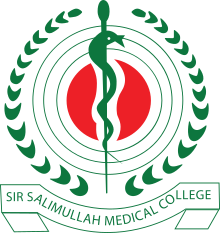 Crest of SSMC | |
Former names | Dhaka Medical School (1875–1962) |
|---|---|
| Type | Public medical college |
| Established | 1875[1] |
| Accreditation | BMDC |
Academic affiliation | University of Dhaka[2] |
| Principal | Md. Nurul Huda Lenin[3] |
| Director of Hospital | Brig. Gen. Md. Mazharul Islam Khan[4] |
Academic staff | 145[1] |
| Students | 1,600[5] |
| Location | , 23°42′38″N 90°24′04″E / 23.7106°N 90.4011°E |
| Campus | Urban |
| Colors | Red and white |
| Website | www |
Sir Salimullah Medical College (SSMC), commonly known as Mitford, is a public medical college in Dhaka, Bangladesh. Founded in 1875, it is the oldest and second largest medical school in Bangladesh.[6] It includes Mitford Hospital, which is the oldest hospital in the country and one of the earliest hospitals in the Indian subcontinent from where the evolution of medical education started.[7][8]
The medical college was established to promote medical education in East Bengal and to provide better healthcare services to the people.[7] It has been producing quality physicians, eminent researchers and health policy makers who are currently working in different medical sectors at home and abroad.[7]
History
[edit]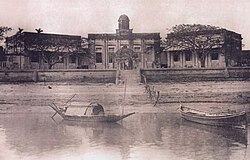

Sir Salimullah Medical College was established in 1875 in Old Dhaka as Dhaka Medical School with Mitford Hospital being a part of the college.[1] Mitford Hospital was named after Robert Mitford, a British colonial official, who funded the hospital.[9] He left his estate to the government of Bengal to establish a medical facility in Dacca.[7] The Governor General of India, James Broun-Ramsay, 1st Marquess of Dalhousie, established Mitford Hospital with the endowment. Funding for the school came from 16 aristocrats and philanthropists of Bengal.[1] Babu Protap Chandra Dash, Gour Netai Shaha Shonkhonidhy, Shontosh Rani Dinmony Chowdhurany, and Shontosh Raja Monmoth Roy Chowdhury contributed funding for the water and sewage facilities of the school.[7]
A medical school, the first of its kind in this region, began its journey on 15 June 1875. Later on, the DC of Dhaka division Mr. W.R. Larmini laid the stone of the academic building in April 1887. In September 1889, Governor of Bengal Sir Steuart Colvin Bayley presided over the opening ceremony of that building.[7]
A total number of 384 students got admitted in the school in the first batch. The number increased by and by. They got admitted for a 4-year course leading to a diploma of LMF (Licentiate of Medical Faculty), offered by the State Medical Faculty.[7]

The LMF course was abandoned in 1957. The medical school was converted to a medical college and named Mitford Medical College in 1962.[7] The next year, governor Abdul Monem Khan renamed it Sir Sallimullah Medical College, after the name of Khwaja Salimullah, Nawab of Dhaka, in recognition of the contribution of the Nawab family to the establishment of the college.[10] From 1963 to 1973, the college offered a condensed MBBS program.[1]
AFM Nurul Islam took the chair of principal and started the condensed course of MBBS in 1963. After the Independence of Bangladesh, Professor Dr Muhammad Ibrahim took the chair of principal and under his direct supervision SSMC started its journey as a full-fledged medical college. On 8 February 1973, the first batch of undergraduates started their classes.[7]
In 1974, the Civil Surgeon of Dhaka was relieved of his duty to oversee the college, after which a principal was appointed for SSMC and a superintendent was appointed for Mitford Hospital.[1] The superintendent position was upgraded to director in 1984.[1]
The postgraduate courses were introduced in January 2002.[7] In May 2008, the college was suffering from a shortage of classrooms.[6] In 2011, a Dental unit was established as a part of the medical college and the first batch of students of BDS course enrolled in 2012.[11]
Campus
[edit]
The campus is located at Mitford Road, Babubazar, Old Dhaka, a historic old part of the Dhaka city.[12] It is spread over about 2.8 acres of land, on the bank of Buriganga river.[13] The medical college building is situated to the south-east of the hospital area, near the river bank with a large garden in front.[14] The building is four-storeyed with a floor space of 4,940 square meters on each floor. The building accommodates the Departments of Anatomy, Pathology, Biochemistry, and Microbiology. The Departments of Physiology, Pharmacology, Community Medicine, and Forensic Medicine are housed in another building in front of the main building.[7]

Mitford Hospital, one of the largest hospitals in Bangladesh, is located adjacent to the college campus. It occupies an oblong area of about 12.8 acres of land on the bank of Buriganga river.[15] The hospital complex comprises more than fourteen buildings, most of which were originally single-storied and later have been raised to multiple storeys. With gradual expansion since its initial foundation, the campus comprises a mix of buildings depicting both modern and colonial architecture.[15]
The main hospital building is eight-storeyed which is commonly known as "Surgery Building", as it houses the surgical units.[7] The outpatient department is located in another building, in front of the main building. The King Edward Building is three-storeyed and houses the medicine units, hence it is commonly known as the "Medicine Building". The building is named after King Edward VII. A marble plaque on the entrance wall depicts a portrait of King Edward VII, to whom the building was dedicated.[7]
Academics
[edit]
Admission
[edit]A countrywide combined medical admission test for MBBS course is held every year under the supervision of DGHS. Students after passing Higher Secondary School Certificate or equivalent examinations with the required grades can apply for the test. In 2024, 250 seats were allocated for MBBS course in Sir Salimullah Medical College.[16] The qualified candidates, according to their preferences, get the opportunity to study at the medical college. Foreign candidates are selected by DGHS and MOHFW as per required qualifications.[17][18]
Undergraduate
[edit]The medical college offers MBBS and BDS degrees at the undergraduate level. It conducts the 5-year courses according to the curriculum developed by Bangladesh Medical and Dental Council.[1] A medical student studies Anatomy, Physiology, Biochemistry, Forensic Medicine, Community Medicine, Pathology, Pharmacology, Microbiology, Medicine, Surgery, Gynecology and Obstetrics during the MBBS course period.[19]
The courses are divided into four phases. Four professional examinations, one at the end of each phase, are held under the University of Dhaka. After passing the final professional examination, a student is awarded the MBBS degree.[20] After graduation, medical graduates are required to undertake one-year of internship training at the Mitford Hospital.[21]
Postgraduate
[edit]The medical college offers MD, MS, MPhil and Diploma in several specialties in affiliation with the University of Dhaka and Bangabandhu Sheikh Mujib Medical University.[22][23] It is also recognized by the Bangladesh College of Physicians and Surgeons for imparting training and conducting courses in various specialties.[24]
Library
[edit]The library is situated on the ground floor of new academic building with a large collection of medical books. SSMC has a developing library section with books about educational innovations, educational psychology, instructional techniques, curriculum development, curriculum evaluation etc. Many WHO and other publications on human resource development for health are also available. The library is enriched with more than 150 journals and 23000 medical books.[25][26]
Dental unit
[edit]In 2011, a Dental unit was established as a part of the medical college. The first batch of students of BDS course enrolled in 2012.[27] A countrywide combined dental admission test is held every year and 52 seats are allocated for dental students in SSMC.[28]
A dental student studies Anatomy & Dental Anatomy, Physiology, Biochemistry, Pharmacology, Pathology, Microbiology, Medicine, Surgery, Periodontology, Oral and maxillofacial surgery, Conservative Dentistry and Endodontics, Prosthodontics and Orthodontics during the course period. After passing the final professional examination, a student is awarded the BDS degree.[29] After graduation, dental graduates are required to undertake one-year of internship training at the Mitford Hospital.[30]
Departments
[edit]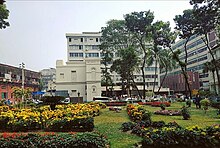
SSMC and Mitford Hospital consist of following departments:[31]
Pre-clinical
- Department of Anatomy
- Department of Physiology
- Department of Biochemistry
Para-clinical
- Department of Community Medicine
- Department of Forensic Medicine
- Department of Microbiology
- Department of Pathology
- Department of Pharmacology
Clinical
- Department of Medicine
- Department of Neurology
- Department of Nephrology
- Department of Cardiology
- Department of Hematology
- Department of Gastroenterology
- Department of Psychiatry
- Department of Dermatology
- Department of Hepatology
- Department of Pediatrics
- Department of Neonatology
- Department of Respiratory Medicine
- Department of Transfusion Medicine
- Department of Surgery
- Department of Pediatric Surgery
- Department of Neurosurgery
- Department of Burn & Plastic Surgery
- Department of Cardiac Surgery
- Department of Orthopedics
- Department of Urology
- Department of Casualty
- Department of Ophthalmology
- Department of ENT and HNS
- Department of Anesthesiology
- Department of Gynae and Obs
- Department of Radiology
Student life
[edit]Hostels
[edit]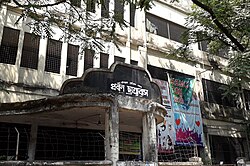
There are five residential halls for accommodation of the students as well as intern doctors. Three hostels for male students and interns are: Main hostel, Alauddin hostel and Intern doctors' hostel.[32] Two hostels for female students and interns are: Ladies hostel and Female Intern doctors' hostel.[33] The ladies hostel suffered from inadequate facilities for the number of female students.[6]
Student organizations
[edit]SSMC pioneered some nationwide appreciated voluntary organizations like Sandhani, Rotaract club, Leo club etc.[34] Medicine Club (a voluntary students' organization) established a unit here in 1990, for the first time outside of Mymensingh Medical College.[35] Following the Non-cooperation movement, all kinds of student politics, clubs, and organizations have been banned by the academic council.[36]
Debate and quiz
[edit]Students of the medical college often participate in debate and quiz competitions. A team participated in the BUP Intervarsity English Debate Competition 2022.[37] A student of this college was announced as the best speaker in BUTEX DC National Debate Fest 2022.[38] Debate and Quiz Society of SSMC, AIUB Department of Public Health and USAID fellows worked closely to arrange the first Global Health Festival in 2014.[39] That year, Debate and Quiz Society also organized the 'IFIC Bank-DQS SSMC Carnival Captive 2014', the event had sections of liberation war olympiad, inter-university debate and quiz competitions, medical spelling competition (medispell) and ideation competition workshop on various topics.[40]
Sports facilities
[edit]SSMC has a large playground located a few blocks away from the main campus, known as Armanitola playground. The ground was built by Nawab Salimullah during the British raj. This is a field of historical significance, the first public meeting of Awami Muslim League was held on this field in 1949.[41]
Now it is used as a venue for annual sports events as well as for cricket and football competitions. Students can access the facility all year round. Besides, the Main hostel has a badminton court and indoor games facilities.[41]
Cultural activities
[edit]
Student organizations of the college arrange several cultural programmes every year.[42] SSMC Day is celebrated each year on the premises on 8 February, the founding day of the institution. A joyous procession circumambulates the campus marking the occasion.[43]
Ranking
[edit]Sir Salimullah Medical College is ranked second among the government medical colleges in Bangladesh by the Ministry of Health and Family Welfare ranking.[44][45]
Recognition
[edit]Sir Salimullah Medical College is listed in the World Directory of Medical Schools.[46] It is approved by the National Medical Commission of India.[47] Graduates of this medical college are eligible to appear in different medical licensing examinations like USMLE, PLAB, AMC, MCCQE and NZREX.[48][49][50]
Alumni association
[edit]
Sir Salimullah Medical College graduates have a strong alumni presence in United States, United Kingdom and Canada. SSMC Alumni Association Abroad is an organization of the alumni who are currently living abroad.[51] The alumni association is involved in exchange of skills and education with the college. They provide scholarship every year to the students of SSMC. The organization responds to national and international crisis, they made donations towards the victims of east coast natural disaster and famine-stricken children of Somalia.[52][53]
Notable people
[edit]Alumni
[edit]-
Benoy Basu, Indian revolutionary
-
Mustafizur Rahman, High Commissioner of Bangladesh to India
-
Sezan Mahmud, physician-scientist, writer
-
Sadia Faizunnesa, Ambassador of Bangladesh to Brazil
- Abul Bashar Mohammed Khurshid Alam, former director general of Directorate General of Health Services[54]
- Sezan Mahmud, writer, lyricist, columnist, Professor of Medical Sciences at Quinnipiac University[55]
- Mustafizur Rahman, diplomat, High Commissioner of Bangladesh to India[56]
- Sadia Faizunnesa, diplomat, Ambassador of Bangladesh to Brazil[57]
- Bidhan Ranjan Roy, adviser of the interim government of Bangladesh[58]
- Azharul Haque, intellectual killed during the Liberation War[59]
- Rakhal Chandra Das, intellectual killed during the Liberation War[60]
- HBM Iqbal, former member of parliament[61]
- Monirul Islam Tipu, former member of parliament[62]
- Somen Chanda, writer, political activist[63]
- Atiqur Rahman, intellectual killed during the Liberation War[64]
- Mohammad Shamshad Ali, intellectual killed during the Liberation War[65]
- Moin Uddin Ahmed, former member of parliament[66]
- Benoy Krishna Basu, Indian revolutionary[67]
- Rawshan Ara, film actress[68]
- Md. Rustum Ali Faraji, Member of Parliament[69]
- Pravat Chandra Barua, epidemiologist, former vice-chancellor of the University of Science and Technology Chittagong[70]
- Mohammad Haris Ali, Independence Award recipient[71]
- Selina Hayat Ivy, Mayor of Narayanganj City Corporation[72]
- Naderuzzaman Khan, politician, Liberation War organizer[73]
Faculty
[edit]- AFM Alim Chowdhury, ophthalmologist[74]
- Zohra Begum Kazi, gynecologist, first Bengali Muslim female physician[75]
- A. Q. M. Badruddoza Chowdhury, former president of Bangladesh[76]
- Muhammad Ibrahim, National Professor of Bangladesh[77]
- Nurul Islam, National Professor of Bangladesh[78]
- AHM Touhidul Anowar Chowdhury, Independence Award recipient[79]
- Pran Gopal Datta, Independence Award recipient[80]
- Indrajit Prasad, endocrinologist[81]
- Badrul Alam, physician, language activist[82]
- Shamsuddin Ahmed, surgeon, intellectual killed during the Bangladesh Liberation War[83]
- Md Sayedur Rahman, pharmacologist, vice-chancellor of BSMMU[84]
- Sayeba Akhter, gynecologist, Ekushey Padak recipient [85]
- Hajera Mahtab, endocrinologist[86]
- William John Virgin, former superintendent of Mitford Hospital[87]
- Mujibur Rahman, medical scientist, Ekushey Padak recipient[88]
- Syed Modasser Ali, ophthalmologist[89]
- Arup Ratan Choudhury, dentist, Ekushey Padak recipient[90]
See also
[edit]- List of medical colleges in Bangladesh
- List of dental schools in Bangladesh
- List of universities in Bangladesh
References
[edit]- ^ a b c d e f g h Hoque, Sydul. "Sir Salimullah Medical College". Banglapedia. Archived from the original on 17 April 2023. Retrieved 13 April 2023.
- ^ "Constituent Colleges". University of Dhaka. Archived from the original on 13 April 2023. Retrieved 13 April 2023.
- ^ "Nurul Huda new principal of Salimullah Medical College". Bangladesh Post. Archived from the original on 13 April 2023. Retrieved 13 April 2023.
- ^ করোনাভাইরাস: মিটফোর্ড হাসপাতালের এত বেশি স্বাস্থ্যকর্মী কেন আক্রান্ত?. BBC News বাংলা (in Bengali). BBC. Archived from the original on 13 April 2023. Retrieved 13 April 2023.
- ^ মামলা জটিলতায় কাজ বন্ধ. Jugantor (in Bengali). Archived from the original on 4 May 2023. Retrieved 4 May 2023.
- ^ a b c Ghias, Durdana (19 May 2008). "Classes held 'anywhere', 6 chairs for 7 lecturers in one room". The Daily Star. Archived from the original on 8 April 2023. Retrieved 8 April 2023.
- ^ a b c d e f g h i j k l m Hossain, Md Rajib. "Celebrating 150 years of Sir Salimullah Medical College". Star Campus. Archived from the original on 21 November 2020. Retrieved 8 April 2023.
- ^ "চলুন ঘুরে আসি দেশের সবচেয়ে প্রাচীন মেডিকেল কলেজ থেকে". Deho.com.bd (in Bengali). Archived from the original on 28 November 2022. Retrieved 15 May 2023.
- ^ Ahmed, Sharif uddin. "Mitford, Robert". Banglapedia. Archived from the original on 8 April 2023. Retrieved 8 April 2023.
- ^ মিটফোর্ড হাসপাতাল থেকে স্যার সলিমুল্লাহ মেডিকেল কলেজ: একটি পর্যালোচনা. Dainik Purbodesh (in Bengali). Archived from the original on 22 May 2023. Retrieved 22 May 2023.
- ^ "Sir Salimullah Medical College Dental Unit". School & College Listings. Archived from the original on 30 April 2023. Retrieved 30 April 2023.
- ^ "Preservation of Old Dhaka historic sites demanded". Tritiyomatra. Archived from the original on 30 April 2023. Retrieved 30 April 2023.
- ^ "Sir Salimullah Medical College". Banglapedia. Archived from the original on 17 April 2023. Retrieved 30 April 2023.
- ^ Ahmed, Nazimuddin (21 February 1986). Buildings of the British Raj in Bangladesh, Edited by John Sanday. University Press Limited. ISBN 9840510916.
- ^ a b "Mitford Hospital". Banglapedia. Archived from the original on 8 September 2023. Retrieved 8 September 2023.
- ^ "২০২৩-২০২৪ শিক্ষাবর্ষে এমবিবিএস ভর্তি বিজ্ঞপ্তি" (PDF). স্বাস্থ্য শিক্ষা অধিদপ্তর. 10 January 2024.
- ^ "List of foreign students selected for admission in Government Medical Colleges". dghs.gov.bd. Archived from the original on 27 April 2023. Retrieved 27 April 2023.
- ^ "বিদেশী শিক্ষার্থীদের মেডিকেলে ভর্তি যে প্রক্রিয়ায়". thedailycampus.com (in Bengali). Archived from the original on 13 November 2023. Retrieved 13 November 2023.
- ^ "Medical Study Pattern in Bangladesh". mbbsbangladesh. Archived from the original on 27 April 2023. Retrieved 27 April 2023.
- ^ "BM&DC". Bangladesh Medical & Dental Council. Archived from the original on 29 October 2019. Retrieved 27 April 2023.
- ^ "Mitford interns call off strike". Prothom Alo. Archived from the original on 4 May 2023. Retrieved 4 May 2023.
- ^ "Office of the Inspector of Colleges. List of Constituent College.pdf" (PDF). Archived (PDF) from the original on 1 May 2023. Retrieved 27 April 2023.
- ^ "Affiliated Institutes". Bangabandhu Sheikh Mujib Medical University. Archived from the original on 28 March 2023. Retrieved 27 April 2023.
- ^ "Bangladesh College of Physicians & Surgeons". bcps.edu.bd. Archived from the original on 1 June 2023. Retrieved 1 June 2023.
- ^ "Library". SSMC. Archived from the original on 25 November 2020. Retrieved 30 November 2020.
- ^ "Sir Salimullah Medical College". RMC education. Archived from the original on 13 April 2023. Retrieved 13 April 2023.
- ^ "Sir Salimullah Medical College Dental Unit". School & College Listings. Archived from the original on 30 April 2023. Retrieved 30 April 2023.
- ^ "বাংলাদেশের ডেন্টাল কলেজ ভর্তি পরীক্ষা". Retina Rajshahi Branch (in Bengali). Archived from the original on 30 April 2023. Retrieved 30 April 2023.
- ^ "BDS Curriculum in Bangladesh". Bangladesh Study Center. Archived from the original on 8 June 2023. Retrieved 30 April 2023.
- ^ "Mitford interns call off strike". Prothom Alo. Archived from the original on 4 May 2023. Retrieved 4 May 2023.
- ^ "SSMC&MH Doctor's profile". ssmcmh.gov.bd. Archived from the original on 1 June 2023. Retrieved 1 June 2023.
- ^ সলিমুল্লাহ মেডিকেলের ছাত্রাবাসে ব্যাপক ভাংচুর চালাল ছাত্রলীগ. Samakal (in Bengali). Archived from the original on 30 April 2023. Retrieved 1 May 2023.
- ^ "Classes held 'anywhere', 6 chairs for 7 lecturers in one room". Daily Star. Archived from the original on 8 April 2023. Retrieved 8 April 2023.
- ^ "SSMC volunteer organisations". Retinabd. Archived from the original on 10 April 2023. Retrieved 10 April 2023.
- ^ "About us". Medicine Club. Archived from the original on 30 April 2023. Retrieved 30 April 2023.
- ^ "3 medical colleges ban student politics". The Daily Star. 11 August 2024. Retrieved 11 August 2024.
- ^ "IUB wins BUP Intervarsity English Debate Competition 2022". Dhaka Tribune. Archived from the original on 30 April 2023. Retrieved 30 April 2023.
- ^ "Curtain Falls for the Auko-Tex Presents BUTEX DC National Debate Fest 2022". The Financial Express. Archived from the original on 30 April 2023. Retrieved 30 April 2023.
- ^ "AIUB Sets Precedence in Global Health Education in Bangladesh". AIUB. 15 June 2014. Archived from the original on 30 April 2023. Retrieved 30 April 2023.
- ^ "Medispell contest at SSMC ends". The New Nation. Archived from the original on 2 May 2023. Retrieved 2 May 2023.
- ^ a b আরমানিটোলা মাঠ ঐতিহ্য হারাচ্ছে. Jugantor. Archived from the original on 8 September 2023. Retrieved 8 September 2023.
- ^ ৮ ফেব্রুয়ারি 'এসএসএমসি ডে'. Medivoicebd (in Bengali). 2 February 2023. Archived from the original on 30 April 2023. Retrieved 30 April 2023.
- ^ "51st founding anniversary of SSMC celebrated". The Business Standard. Archived from the original on 30 April 2023. Retrieved 30 April 2023.
- ^ "সরকারী মেডিকেল কলেজ (সকল)". Directorate General of Medical Education (in Bengali). Archived from the original on 4 May 2023. Retrieved 4 May 2023.
- ^ "A list of Govt. Medical Colleges" (PDF). Archived (PDF) from the original on 13 July 2022. Retrieved 4 May 2023.
- ^ "Sir Salimullah Medical College". World Directory of Medical Schools. Archived from the original on 9 September 2023. Retrieved 9 June 2023.
- ^ "List of NMC approved medical colleges in Bangladesh". sheenstein.com. Archived from the original on 26 August 2023. Retrieved 10 September 2023.
- ^ "Registration policy". Medical Council of New Zealand. Archived from the original on 20 January 2019. Retrieved 9 September 2023.
- ^ "ECFMG Medical School Listing Policy". ECFMG. Archived from the original on 9 September 2023. Retrieved 9 June 2023.
- ^ "Self-check of eligible schools, medical degrees". Australian Medical Council. Archived from the original on 8 June 2023. Retrieved 9 June 2023.
- ^ "Home". SSMC Alumni Association Abroad. Archived from the original on 8 August 2022. Retrieved 8 April 2023.
- ^ "SSMC Alumni Abroad". SSMC Alumni Association Abroad. Archived from the original on 8 August 2022. Retrieved 1 December 2020.
- ^ "Sir Salimullah Medical College Alumni". Day of Difference. Archived from the original on 13 April 2023. Retrieved 13 April 2023.
- ^ স্বাস্থ্য অধিদফতরের নতুন ডিজি কে এই ডা. খুরশীদ?. Jugantor (in Bengali). Archived from the original on 24 July 2020. Retrieved 8 April 2023.
- ^ "Saleh M. Rahman, MD". qu.edu. September 2022. Archived from the original on 21 May 2023. Retrieved 21 May 2023.
- ^ "Muhammad Imran new ambassador to US, Mustafizur Rahman high commissioner to India". The Daily Star. 13 July 2022. Archived from the original on 1 June 2023. Retrieved 1 June 2023.
- ^ "Sadia Faizunnesa appointed as new ambassador to Brazil". bdnews24.com. Retrieved 22 December 2023.
- ^ "Yunus-led interim govt sworn in". The Daily Star. 8 August 2024. Retrieved 9 August 2024.
- ^ "Haque, Azharul". Banglapedia. Archived from the original on 8 April 2023. Retrieved 8 April 2023.
- ^ "Das, Rakhal Chandra". Banglapedia. Archived from the original on 8 April 2023. Retrieved 8 April 2023.
- ^ "Chairman - Home". Premier Bank Limited. Archived from the original on 4 April 2023. Retrieved 1 May 2023.
- ^ "চলে গেলেন ডা. মনিরুল ইসলাম". medivoicebd.com (in Bengali). 28 March 2021. Archived from the original on 28 September 2023. Retrieved 22 December 2023.
- ^ Vol - I, Subodh C. Sengupta & Anjali Basu (2002). Sansab Bangali Charitavidhan (Bengali). Kolkata: Sahitya Sansad. p. 606. ISBN 81-85626-65-0.
- ^ Reaz, Bayzid Khurshid. "Rahman, Atiqur". Banglapedia. Archived from the original on 14 August 2017. Retrieved 1 May 2023.
- ^ Khan, Muazzam Hussain. "Ali, Mohammad Shamshad". Banglapedia. Archived from the original on 16 August 2017. Retrieved 1 May 2023.
- ^ "চাঁপাইনবাবগঞ্জ জেলার শিবগঞ্জ উপজেলার প্রখ্যাত ব্যক্তিত্ব". Bangladesh National Portal (in Bengali). Archived from the original on 16 April 2020. Retrieved 2 September 2023.
- ^ "Basu, Benoy Krishna". Banglapedia. Archived from the original on 8 April 2023. Retrieved 8 April 2023.
- ^ "ঢাকাই চলচ্চিত্রের অভিনেত্রী ডা. রওশন আরা". nagorik.news (in Bengali). 27 June 2024. Retrieved 13 July 2024.
- ^ "Dr. Md. Rustum Ali Faraji". AmarMP. 10 August 2020. Archived from the original on 30 April 2023. Retrieved 1 May 2023.
- ^ "Prof Dr Pravat Barua made USTC VC". The New Nation. Archived from the original on 21 May 2023. Retrieved 21 May 2023.
- ^ স্বাপ্নিক এবং সংগ্রামী ডাক্তার হারিছ আলী. drharisali.com. Archived from the original on 3 October 2023. Retrieved 12 September 2023.
- ^ "Dr. Selina Hayat Ivy". ncc.portal.gov.bd. Archived from the original on 3 October 2023. Retrieved 12 September 2023.
- ^ মরহুম ডা. নাদেরুজ্জামান খানের বর্ণাঢ্য জীবন. bd24views.com (in Bengali). 18 June 2021. Retrieved 23 December 2023.
- ^ Reaz, Bayzid Khurshid (2012). "Chowdhury, AFM Abdul Alim". In Islam, Sirajul; Jamal, Ahmed A. (eds.). Banglapedia: National Encyclopedia of Bangladesh. Archived from the original on 4 October 2017.
- ^ Akhtar, Shirin (2012). "Kazi, Zohra Begum". In Sirajul Islam; Miah, Sajahan; Khanam, Mahfuza; Ahmed, Sabbir (eds.). Banglapedia: the National Encyclopedia of Bangladesh (Online ed.). Dhaka, Bangladesh: Banglapedia Trust, Asiatic Society of Bangladesh. ISBN 984-32-0576-6. OCLC 52727562. OL 30677644M. Retrieved 22 November 2024.
- ^ "AQM Badruddoza Chowdhury". Banglapedia. Archived from the original on 29 September 2018. Retrieved 1 May 2023.
- ^ একজন ডা. ইব্রাহিম. Daily Inqilab (in Bengali). Archived from the original on 4 May 2023. Retrieved 4 May 2023.
- ^ Mintu Chowdhury (24 January 2013). "National Prof Nurul Islam dies". bdnews24.com. Archived from the original on 3 May 2023. Retrieved 1 May 2023.
- ^ "Professor T A Chowdhury, Bangladesh" (PDF). South East Asia Journal of Public Health. 4 (2): 59. 2015. doi:10.3329/seajph.v4i2.24053.
- ^ Ahmad, Md Sarwar. "A freedom fighter and physician dedicated to the cause of humanity". The Asian Age. Bangladesh. Archived from the original on 2 September 2023. Retrieved 2 September 2023.
- ^ "Dr. Indrajit Prasad". Dhaka Medical College. Archived from the original on 26 June 2023. Retrieved 2 September 2023.
- ^ "Dr. Badrul Alam". Bhorer Kagoj (in Bengali). 14 February 2019. Archived from the original on 16 January 2020. Retrieved 1 May 2023.
- ^ Khan, Muazzam Hussain (2012). "Ahmed, Shamsuddin3". In Sirajul Islam; Miah, Sajahan; Khanam, Mahfuza; Ahmed, Sabbir (eds.). Banglapedia: the National Encyclopedia of Bangladesh (Online ed.). Dhaka, Bangladesh: Banglapedia Trust, Asiatic Society of Bangladesh. ISBN 984-32-0576-6. OCLC 52727562. OL 30677644M. Retrieved 22 November 2024.
- ^ "Sayedur Rahman to become new VC of BSMMU". bdnews24.com. Retrieved 3 September 2024.
- ^ নারীদের প্রসব-পরবর্তী জটিলতা ঠেকালো যার উদ্ভাবন. Ittefaq (in Bengali). Archived from the original on 2 May 2023. Retrieved 2 May 2023.
- ^ "Board Of Trustees". Bangladesh University of Health Sciences. Retrieved 22 December 2023.
- ^ Zaman, Habibuz (1999). "Dhaka Medical College: The early years". Seventy years in a shaky subcontinent. London: Janus. p. 135. ISBN 1-85756-405-7. OCLC 43210443.
- ^ Md Fazlur Rahman (6 March 2014). "Of blood transfusion architect". The Daily Star. Archived from the original on 21 May 2023. Retrieved 22 May 2023.
- ^ "Siddique made adviser". bdnews24.com. 7 January 2009. Retrieved 31 July 2024.
- ^ "ড. অরূপ রতন চৌধুরীর সিলেট-২ আসনে প্রার্থীতা ঘোষণা". dainiksylhet.com. 8 July 2023. Archived from the original on 3 October 2023. Retrieved 13 September 2023.
 KSF
KSF


